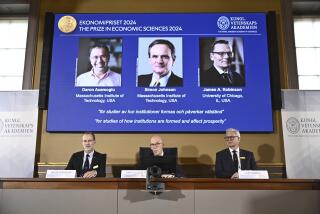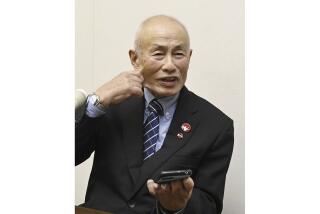Americans Shut Out of Science Nobels : Awards: Swiss chemist and French physicist are recipients of the prestigious honors. It marks the first time since 1971 that neither prize has gone to someone from the U.S.
A Swiss chemist and a French physicist were awarded the 1991 Nobel Prizes in their fields Wednesday, the first time since 1971 that Americans have been shut out from the two prestigious awards.
Pierre-Gilles de Gennes of the College de France in Paris received the physics award for his studies of the behavior of a wide range of materials, particularly the “liquid crystals” that are commonly used in the displays of calculators and watches.
Richard R. Ernst of the Eidgenoessische Technische Hochschule in Zurich received the chemistry prize for refining the analytical technique called NMR spectroscopy, which is one of the most widely used techniques for determining the structures of chemical substances. His studies also made possible magnetic resonance imaging (MRI), commonly used for studying the interior of the human body.
Each will receive more than $1 million when the prizes are formally presented in Stockholm on Dec. 10.
This marks the first time since 1948 that an American has not won in at least one of the three science and medicine categories. Two Germans won the medicine prize last week.
Some critics have charged that America’s share of Nobel Prizes will suffer from reductions in science funding, but scientists said Wednesday that it is much too soon for such cuts to be reflected in the prize distribution.
De Gennes, 58, developed theorems that describe mathematically what happens to systems when they are converted from a chaotic state to a highly organized one and vice versa.
His ability to show theoretical similarities among such physically different systems led some of judges at Royal Swedish Academy of Sciences refer to him in the award citation as “the Isaac Newton of our time.”
His theories were particularly important in developing practical applications of liquid crystals, materials that retain the precise alignment of crystals even though they flow like liquids. They are widely used in thermometers, voltage indicators on battery packages and even in mood rings.
The same principles also govern the behavior of magnets, polymer solutions and superconductors.
De Gennes celebrated the award Wednesday in his Zurich laboratory with friends and champagne. “All my research, however fundamental, is always motivated by practicality,” he told Associated Press. He is working, he said, on the development of super glues that could hold airplanes together without rivets, thereby making them lighter and easier to assemble.
A skier and a windsurfer, De Gennes has seven children. A devout family man, he said that the Nobel was not the highlight of his career. “I find that the crowning moment of our life is not in compensation--most of all, it’s in our children.”
Ernst, 58, made a fundamental breakthrough in nuclear magnetic resonance (NMR) spectroscopy between 1963 and 1968 when he worked for Varian Associates in Palo Alto. He and Weston Anderson of Varian did the initial work on the technique, called Fourier transform NMR spectroscopy, that greatly speeded up the acquisition of data about each atom in a molecule, thereby allowing biologists to use the technique on very small quantities of material. For example, NMR can be used to determine the three-dimensional structure of enzymes and other components of the cell.
“With classical techniques, it could take years to determine molecular structures,” said Salo Gronowitz, chairman of the awards committee. “Now it can take hours or days.”
By analogy, their technique could be considered similar to information obtained from each AM and FM station on the radio dial simultaneously, rather than having to listen to each one separately.
Ernst received news of the award while flying across the Atlantic to receive another award at Columbia University. Speaking to wire service reporters over the jet’s cockpit radio, he said, “It really is special, something I have never experienced and will never experience again.”
The rare shutout of American scientists may be a harbinger of future shifts in world dominance resulting from changes in U.S. funding patterns for research and development.
Several leading American scientists have expressed concerns lately over what they perceive to be inadequate funding for science education in the United States and the impact that could have on the kind of research that leads to Nobel Prizes. Most said, however, that the lack of success by U.S. scientists this year cannot be blamed on current cutbacks in science education because Nobels usually are awarded for work done many years before.
“There are those who fear we are cutting back on our support of science and that will have some impact down the road,” said Glenn T. Seaborg of UC Berkeley, who won the chemistry award in 1951. “But I think that will be some time in the future, not now.”
The Winning Theory
Pierre-Gilles de Gennes received the physics Nobel for his work in explaining the physical characteristics of materials as they change from a chaotic, disordered state to an ordered one.
One good example of this change is provided by liquid crystals, which are widely used in calculator and watch displays.
The same principles govern the behavior of molecules in electromagnets, superconductors and solutions of polymers.
1. In the absence of an electrical current, the liquid crystals are normally twisted.
2. When polarized light passes through them, its plane of vibration is twisted by 90 degrees.
3. That allows the light to pass through a pair of filters set at right angles to each other.
4. When a weak electrical current is applied to the liquid crystals, they line up so that the plane of polarized light is no longer affected.
5. The passage of light is thus blocked, forming dark numbers.
The Winners
Physics: Pierre-Gilles de Gennes
Age: 58
Career: Started teaching at the University of Paris at Orsay in 1961. Since 1971, he has been professor of physics at the College de France, France’s top graduate institute. Since 1976, he also has directed the Paris physics and chemistry college.
His work: Developed mathematical models that help explain how molecules pass from an ordered to a disordered state at a specific temperature, a discovery with ramifications for the field of superconductors.
Award: De Gennes was cited for “discovering that methods developed for studying order phenomena in simple systems can be generalized to more complex forms of matter, particularly liquid crystals and polymers.”
Chemistry: Richard Ernst
Age: 58
Career: Ernst, who is Swiss, is professor of physical chemistry at a Zurich college, the Eidgenoessiche Technische Hochschule. From 1963 to 1968 he was a research scientist at Varian Associates in Palo Alto.
His work: Ernst helped create a major breakthrough in 1966 by discovering how to increase the sensitivity of multidimensional measuring techniques. It has application in drug production and human biology.
Citation: The Royal Swedish Academy of Sciences cited Ernst’s contributions to the development of a measuring technique used widely in chemistry known as a nuclear magnetic resonance (NMR) spectroscopy.
More to Read
Sign up for Essential California
The most important California stories and recommendations in your inbox every morning.
You may occasionally receive promotional content from the Los Angeles Times.









